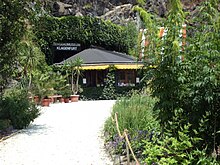Klagenfurt Mining Museum

The Klagenfurt Mining Museum presents the history of Carinthian mining . It was first opened in 1973 as a privately operated mining museum . Since 1977 in a former will air raid shelters of Kreuzbergl housed the Museum of the City of Klagenfurt operated. The mining museum has been closed since November 1st, 2015.
History of the museum
The museum is located in a 500 meter long tunnel. From mid-1942 this was driven as an air raid shelter in a quarry in the Kreuzbergl that had previously been used for the extraction of green slate . After the Second World War, the so-called rock hall of the facility housed the Klagenfurt radio station of the Alpenland broadcasting group from August 1945 to 1953 . In 1945 there were other interested parties for the remaining rooms of the tunnel, including a Burgenland winery, who were rejected. In September 1947, the city of Klagenfurt leased the tunnel, with the exception of the premises used by the Alpenland broadcasting group, to a mushroom grower. It is not known how long this kennel was in operation.
In 1958, the state of Carinthia began building the botanical garden on the site in front of the tunnel instead of the pre-war site at the Rudolfinum . Franz Kahler and Franz Müller, who were busy with this task for several years, were commissioned to do this. The latter worked as a garden architect and at the end of the 1960s began to be interested in the now abandoned air raid shelter. As a part-time job, Franz Müller was very interested in mineralogy and an extensive mineral and rock collection, for which he began to use the generous space in the tunnel - the idea of founding a museum was born.
After Müller had invited some politicians and convinced them of his idea, an underground museum was built in 1973 with the help of the State of Carinthia, the City of Klagenfurt and a number of local mining companies as well as the Natural Science Association for Carinthia , which was opened as a private company on November 11, 1973. Organizational and financial problems, however, led to sales negotiations with the city as early as 1975. After this had been slow, Müller sold part of his collection, the exhibits remaining in the museum finally changed hands on May 23, 1977 in return for an annuity . Since then, the city of Klagenfurt has operated the mining museum as a public museum. The founder Franz Müller died on August 23, 1989.
On November 1, 2015, the mining museum was closed as part of cost-saving measures by the city of Klagenfurt. It is unclear whether it will reopen.
exhibition
The Klagenfurt mining museum has around 3000 m² of exhibition space. The large entrance hall ("Felsenhalle") is used for regularly changing special exhibitions.
Didactically, the museum is divided into three subject areas, which on the one hand cannot be treated separately from an economic point of view, but on the other hand each is independent.
Carinthia's mining history
The focus in the area of the mining history of mining in Carinthia is not in the area of technology, i.e. the exhibiting of machines and devices, but in the social area. The life of the miners and their social environment is illuminated with the help of photos, certificates and various other objects such as a replica miners' room. Carinthia's culture is, even if today with very few exceptions - in Waldenstein at the foot of the Packalpe , iron mica is still mined, at the Millstätter Alpe until recently a large amount of magnesite was extracted - no commercial mining has been practiced since the Romans and The Celts are closely linked to mining and have left many traces in modern times until the mining heyday.
mineralogy
The museum offers a cross-section of the mineralogy in Carinthian mining. Numerous exhibits come from the lead-zinc mineralization of the Drauzug from the mining in Bleiberg / Kreuth, which was closed in 1993 . The variety of shapes and colors of wulfenite crystals stands out among the Bleiberger minerals on display . Wulfenite was first described in Bleiberg by Franz Xaver von Wulfen in 1785 and named after him. Another specialty he discovered and exhibited in the mining museum is the Bleiberger shell marble .
Other mineralogical exhibits come from iron ore mines in Hüttenberg , Waitschach and a number of other locations, for example, around 300 mineral species from this area come from the Sau and Koralpe area . Furthermore, the visitor gains insight into the mineralogy of the iron mica mining in Waldenstein, the magnesite mining and the garnet varieties on the Millstätter Alpe and the Laufenberg, as well as other region-specific deposits, not least the considerable gold finds in the Hohe Tauern .
paleontology
In the paleontological department, fossilized remains of animals and plants ( fossils ) from past geological ages are shown. The Carinthian Mining Museum is in possession of finds from all over the world, which are shown and explained according to geological ages. The exhibits explain around 500 million years of geological history. The section ends with the presentation of a 1: 1 replica of the glacier corpse from Tisenjoch in the Ötztal Alps (“ Ötzi ”).
source
- Bergbaumuseum Klagenfurt (ed.): The museum in the mountain . 16-page brochure on the Klagenfurt Mining Museum, as of July 2013.
Web links
- http://bergbaumuseum-klagenfurt.at/ ("in revision" during the closure, as of November 1, 2015)
Individual evidence
- ↑ a b Mining Museum in front of the Aus kleine-zeitung.at, October 30, 2015
Coordinates: 46 ° 37 ′ 44 ″ N , 14 ° 17 ′ 35 ″ E